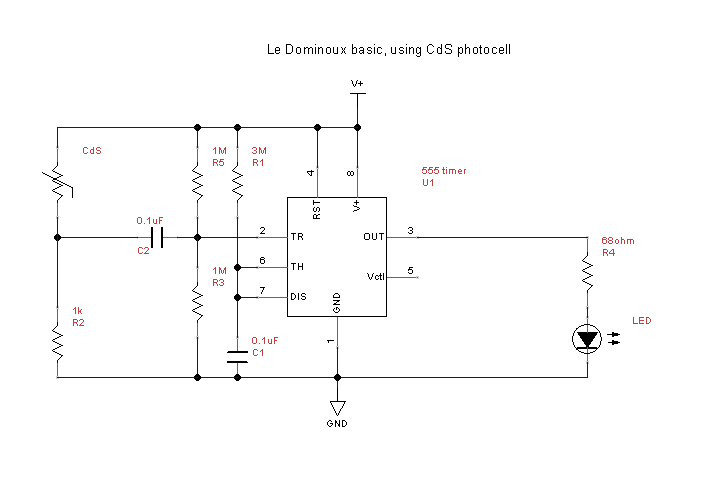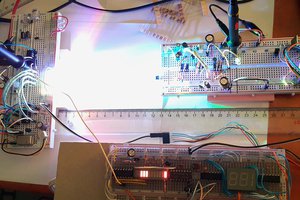[from the project archives]
Le Dominoux are “LED dominoes”, a blinking LED that propagates from device to device. Each Dominoux comprises a coin cell-powered 555 timer circuit configured as a one-shot, triggered either by a photo transistor or CdS photocell. Using a bunch of Dominoux enables creating various lighting patterns, trains, and continuous loops. Other Dominoux variants are the basic blinky for generating light pulses, and a tone generator for making annoying beeps.
For construction I chopped up RadioShack protoboards into small squares and placed the 555 on the component side and direct-soldered all other components on the solder side. I bent a paper clip to make a combination battery holder and stand, insulating the + side with a piece of masking tape. The shiny clips take to solder, the duller ones don’t (perhaps corroded?) I left the CdS cell leads long and insulated one of them so they could be bent a bit — this gives placement flexibility and worked well.
When operating (with the LED off) the power consumption is around 100 microAmps, depending on ambient lighting. This low power is typical of the CMOS variant of the 555. The CdS variant will draw more power in brighter ambient light. The LEDs draw about 10mA when lit.
I intended to build more tone generators but the piezo speakers I acquired weren’t suitable for lower tones, and the green LEDs I used weren’t bright enough to trigger other Dominoux when operating in pulse mode. The brighter red LEDs worked but my supply ran out.
I also found that the CdS photocells responded better to red light than green, and they’re more sensitive to ambient light. This makes videoing these variants difficult as they won’t operate reliably if there’s enough light to capture good video.
Improvements:
LED selection – using high-efficiency red wide-angle (30 degrees or more) work best. Unfortunately I had mostly green 20 degree LEDs which worked, but restricted the Dominoux placement angle.
Photo transistor selection – I used Vishay ambient light detectors (TEPT4400, $0.35 at Mouser) which have a detection cone of 40 degrees. Using a wider-angle detector may help improve placement angle, but these devices are very low power and relatively cheap. The RadioShack CdS cells work well at most angles but cost more and may not trigger with brighter ambient light.
Cost: most of the components were purchased from Mouser.com and a few items from a local RadioShack (they surprisingly carry hobby items!) Each Dominoux costs about $1.75, not including labor.



This work is licensed under a Creative Commons Attribution-NonCommercial-ShareAlike 3.0 Unported License.

 Randy Elwin
Randy Elwin


 mircemk
mircemk
 Jovan
Jovan
 AVR
AVR
I wish I can transmit data using those things. Optical mesh network. Like it.